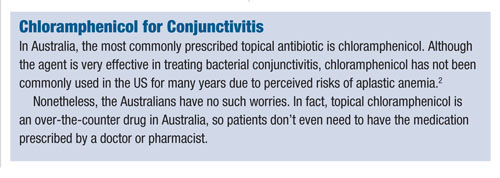 I have always enjoyed lecturing in other countries and meeting colleagues from across the world. One of my favorite international gatherings is the Tasmania Lifestyle Congress in Hobart, Australia. It is a lovely event in a beautiful harbor town. The education is outstanding and the delegates in attendance are among the brightest I have ever encountered.
I have always enjoyed lecturing in other countries and meeting colleagues from across the world. One of my favorite international gatherings is the Tasmania Lifestyle Congress in Hobart, Australia. It is a lovely event in a beautiful harbor town. The education is outstanding and the delegates in attendance are among the brightest I have ever encountered.
I enjoy making comparisons between the practice of optometry in Australia and the United States, and genuinely believe what happens in eye care in one country will somehow be mirrored in the other.
Aussies vs. Yankees
• Therapeutic privileges. Optometrists gained therapeutic privileges long ago in the United States. It was a lengthy, arduous process that still presents several limitations today.
Clearly, optometrists in Australia experienced many of the same problems and growing pains that we dealt with years ago. However, it shouldn’t be surmised that optometrists in other countries trail far behind their American counterparts. Actually, in several ways, they may have advantages over US optometrists.
One progressive step that Australian optometrists have made, which has yet to be taken here, is interstate parity in prescribing rights. For example––while oral prescribing laws vary from state to state in the US, the scope of optometry across Australia is now uniform. That is, the same practice standards exist in all Australian states, with consistent treatment privileges across the country.
• Specialist referrals. Recently, Australian optometrists took another step forward with the dissolution of the glaucoma comanagement rule. Now, Australian optometrists are able to treat open-angle glaucoma independent of ophthalmologists, and no longer have to refer out for comanagement. This significantly increases access to care for Australian citizens, as the wait time for a specialist appointment often takes several months.
It remains to be seen how the Affordable Care Act will impact the practice of optometry in the US. With increased access to insurance, more patients likely will be seeking care. Optometry has always been a gatekeeper for primary eye care. So, it is possible that the wait time for specialists could increase dramatically in the US, similar to that seen in Australia and Canada.
Now more than ever, US optometrists need to embrace the therapeutic aspect of practice. Patients will need medical eye care at an unprecedented level. Longer wait times for specialist consultations means that we will need to shoulder the therapeutic burden.
Australian Pharmacists’ Role in Eye Care
If these are not sufficiently compelling reasons for optometrists to embrace medical eye care, then let me share with you another change that recently occurred in Australia. Pharmacists have increased their scope of practice and now have therapeutic prescribing rights. Again, this stems from the extensive wait times for specialists in Australia.
For example, Australian pharmacists can provide a one-month supply of anti-hypertensive medications, statins and glaucoma medications without a prescription. Keep in mind that pharmacists are not diagnosing and treating these conditions, but are providing an emergency supply to patients until they can see their doctor. Of course, it remains to be seen how many patients may abuse this assistance and keep getting an “emergency supply” month after month without seeing a doctor.
What was most interesting to learn, however, is that pharmacists can now actually diagnose and prescribe for common eye conditions without the patient/customer ever having to see a doctor. The most common condition that pharmacists independently diagnose and treat is bacterial conjunctivitis. As we know, pharmacists do not typically have biomicroscopes to assist them in evaluating ocular conditions. It is very commonly accepted that bacterial, viral and allergic conjunctivitis often have some overlap in signs and symptoms, sometimes making an accurate diagnosis difficult even with a biomicroscope.
In the vast majority of cases, acute bacterial conjunctivitis is a self-limiting disease. However, most published reports indicate that despite its benign, self-resolving nature, bacterial conjunctivitis should be treated with topical antimicrobial therapy in order to shorten the disease course and improve the rate of clinical and microbiologic remission.1 This is especially true early in the clinical course.
A primary concern associated with pharmacists prescribing for eye conditions is that many diseases present with superficial likenesses. Anterior uveitis could present early with similarities to simple conjunctivitis. Additionally, bacterial keratitis could appear similar to bacterial conjunctivitis. Therefore, a pharmacist not employing a biomicroscope could potentially under-treat a condition, leading to significant visual consequences.
To be fair, Australian pharmacists are not likely to prescribe beyond their comfort level. In fact, during my discussion with an Australian pharmacist, she said that she would refer the patient to an optometrist if there were any uncertainties (likely because she knew the difficulty in obtaining an ophthalmology appointment).
While the expanding role of Australian pharmacists may seem to have no bearing on our US practices, we have to be cognizant that patients always will require care. And, if there is a dearth of providers to deliver that care, other health care professionals must step in to fill the void.
Across the United States, pharmacists are successfully administering immunizations for influenza, pneumonia and herpes zoster. I happily get my own immunizations from a pharmacist.
As more patients flood into the health care system, it is not inconceivable that pharmacists may someday have prescribing rights for ocular diseases. In other words, what has successfully transpired in Australia could someday occur in the US if there are not enough eye care practitioners available who are willing to practice medical eye care.

1. Sheikh A, Hurwitz B. Antibiotics versus placebo for acute bacterial conjunctivitis. Cochrane Database Syst Rev. 2006 Apr 19;(2):CD001211.
2. Rose PW, Harnden A, Brueggemann AB, et al. Chloramphenicol treatment for acute infective conjunctivitis in children in primary care: a randomized double-blind placebo-controlled trial. Lancet. 2005 Jul 2-8;366(9479):37-43.

